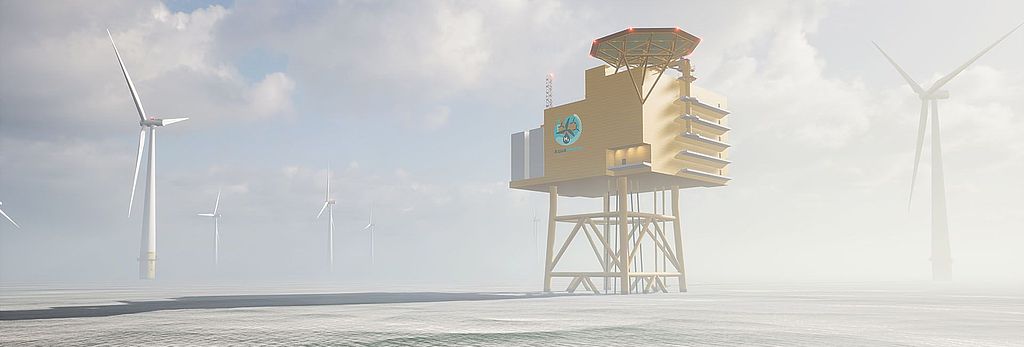
Green hydrogen (H2)
What role does green hydrogen (H2) play in the energy transition?
The EU and Germany aim to become climate-neutral by 2050. Green hydrogen will be one of the key components of the transformation path towards a cleaner and lower-carbon economy. Not least in Germany, for example, also due to the adopted National Hydrogen Strategy of the Federal Government, which aims to make green hydrogen marketable and enable its industrial production, transportability and usability. The production of green hydrogen from renewable energies at sea can make a significant contribution to this (see AquaVentus).
How is green hydrogen produced?
With the help of electricity, water is split into hydrogen and oxygen. This process is called electrolysis. Both drinking water and desalinated seawater can be used to produce hydrogen (H2). When renewable energies such as wind power and solar energy are used to produce hydrogen, this is referred to as green hydrogen.
Green, grey, blue, turquoise hydrogen
Hydrogen is generally a colourless gas. Depending on whether fossil or renewable energy sources are used in the production process, it is referred to as green hydrogen, grey hydrogen, blue hydrogen and turquoise hydrogen.
- Green hydrogen is produced by electricity from renewable energy sources such as wind power and solar energy and is therefore CO2-neutral.
- Grey hydrogen is mostly produced from fossil natural gas, producing about 10 tonnes of CO2 per tonne of hydrogen.
- Blue hydrogen is somewhat more climate-friendly than grey hydrogen, as a maximum of 90% of the CO2 can be captured and storaged in the ground - this is called CSS (Carbon Capture and Storage).
- Turquoise hydrogen is produced by the thermal splitting of methane (methane pyrolysis), the process is currently still in the development phase and results in the production of solid carbon instead of CO2.
Accordingly, only green hydrogen is climate-friendly, which justifies its great importance in relation to the energy transition.
Areas of application for green hydrogen in the energy sector and mobility sector
Green hydrogen and its derivatives (such as green ammonia) will play a key role in the decarbonisation of the industrial and transport sectors. The most important application area is the use of hydrogen as a raw material and fuel in industry (especially in the production of chemicals, plastics, steel), as green hydrogen is the only way to make certain processes in the chemical industry more climate-friendly and, for example, to replace coal in the steel industry.
Hydrogen can also be used as a fuel in aviation, shipping, for trains, buses & trucks as well as for cars. H2 is an alternative regenerative energy source, especially in areas of application where electrification is difficult or does not make sense, such as air traffic, long-distance traffic, heavy goods traffic and shipping. Here, hydrogen serves as a feedstock for synthetic fuels, in addition to direct hydrogen refuelling.
Furthermore, hydrogen can serve as a source of electricity and heat, thanks to fuel cell technology. Thus, another area of application is to supply houses and buildings with energy (heat, electricity).
Hydrogen as part of Mabanaft's sustainable fuels strategy
We believe that the transformation towards cleaner and lower carbon economy will require a broad range of solutions to secure the future energy needs of our customers. Green hydrogen will be one of the key components of this transformation. We are a member of the AquaVentus association, which aims to install a total of 10 gigawatts of offshore wind turbines in the North Sea between Helgoland and the Sandbank Doggerbank by 2035. One million tons of green hydrogen per year could soon be produced on the high seas.
Our stake in energy-storage specialist NACOMPEX underlines our commitment to play an active role in shaping the energy transition and to offer our customers innovative solutions that they can use to reduce their CO2 emissions.
Status: March 2022
All information subject to change. Errors and omissions excepted.

